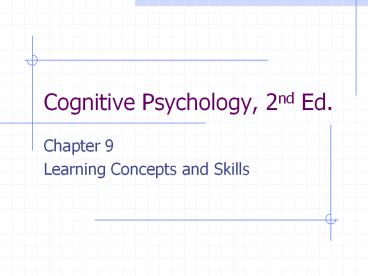Cognitive Psychology, 2nd Ed. - PowerPoint PPT Presentation
Title:
Cognitive Psychology, 2nd Ed.
Description:
Cognitive Psychology, 2nd Ed. ... Implicit tasks involve many stimulus dimensions related by complex rules, ... music, dance tennis, skating, medical diagnosis and ... – PowerPoint PPT presentation
Number of Views:113
Avg rating:3.0/5.0
Title: Cognitive Psychology, 2nd Ed.
1
Cognitive Psychology, 2nd Ed.
- Chapter 9
- Learning Concepts and Skills
2
Concept Learning
- Understanding space-time is fundamental. Object
permanance allows an infant to represent objects
are permanent entities that do not vanish when
out of sight. - 4-5 month olds make the AB error in searching for
a missing object. By 9 months the concept is
grasped. But even at 5 months preferential
viewing of a novel number of objects suggests the
beginnings of object permanance and numerosity.
3
(No Transcript)
4
Concept Learning
- Basic concepts constitute the most informative
level of object categorization. Its
characteristic features are common and correlated
(e.g., bird). Subordinate concepts are even more
so, but carve the world at too fine a grain (e.g.
crow). Superordinate concepts are too general
(animal). - Frequency of exposure rather than hierarchical
level appears to determine age of acquisition.
Infants learn dog-cat-bird contrasts because of
frequent examples.
5
Learning Processes
- The frequency of occurrence of stimulus features
is automatically accumulated, providing a basis
for identifying defining features and typicality
effects. - Learners also actively test hypotheses, requiring
controlled processing in working memory, to
identify defining features.
6
(No Transcript)
7
(No Transcript)
8
Prototype Acquisition
- Abstraction of a central tendency prototype may
involve processes that calculate either mean,
median, or modal values. Instead a frequency
count and perceptual error may account for
apparent variations. The mode may only look like
the mean or median. - Nonanalytic strategy of storing specific
examplars is an alternative to abstraction.
Cortical dissociation in neuroimaging plus
behavioral data suggest exemplar storage is
insufficient by itself to explain abstraction.
9
(No Transcript)
10
(No Transcript)
11
Implicit Learning
- Refers to the unconscious acquisition of complex
rules that cannot be verbalized. Implicit tasks
involve many stimulus dimensions related by
complex rules, not simple conjuctions and
disjunctions. - Artificial, finite state grammars reflect the
complexity of natural language grammars.
Learners can categorize new strings but cannot
articulate the underlying rules. Implicit
learning or examplar storage are contrasting
explanations.
12
(No Transcript)
13
(No Transcript)
14
Implicit vs.Explicit Learning
- Connectionist (frequencies) or symbolic (rule).
- U-Mode-unselective, passive, unreportable.
- Symbolic rule or specific exemplars.
- S-Mode-selective, effortful, and reportable.
15
Acquiring Expertise
- Skills involve perceptual, motor, and cognitive
functioning. Contrast running versus reading,
for example. - Skills require procedural nondeclarative memory,
but declarative memory is further involved in
learning about a domain (e.g., contrast a pro
football player with a surgeon).
16
Expert-Novice Differences
- Refer to differences in mental representations
and cognitive processes associated with
domain-specific expertise. - Comparisons of average person with world-class
performer in chess, mathematics, music, dance
tennis, skating, medical diagnosis and more have
shed light on skill learning.
17
(No Transcript)
18
Skill Acquisition
- Early, intermediate, and final stages of
acquisition moves from declarative, controlled
learning to procedural, automatic performance. - Principal of procedural reinstatement states that
a skill is well-retained for long periods of time
when the procedures used to acquire it are
reinstated precisely at test. Skills can be
immune from forgetting, but transfer to new
conditions negligible. - Deliberate practice for 10 years minimum needed
to attain world class performance.
19
Expert-Novice Differences
- Folk theories of novices cause reasoning errors
in physics problems. Experts unaffected by
problem context. - Metacognitive control--experts reflect on problem
first before calculating. - Experts mnemonically encode information and
develop sophisticated retrieval structures for
rapid access to information in long-term memory
(sometimes called long-term working memory). - Speed increases and errors decrease with practice
according to a power law.
20
(No Transcript)
21
(No Transcript)
22
(No Transcript)
23
(No Transcript)
24
(No Transcript)































